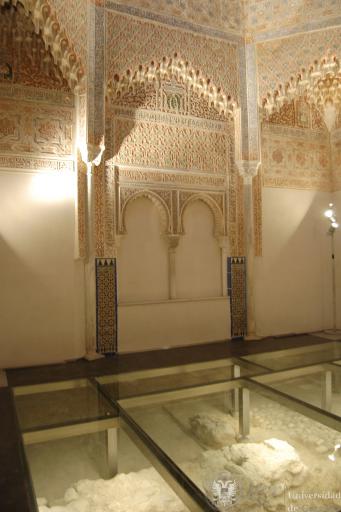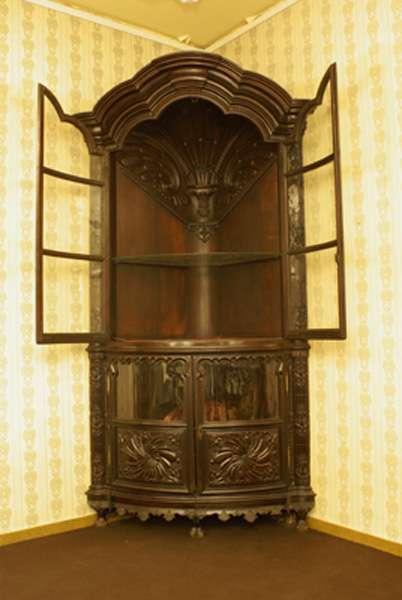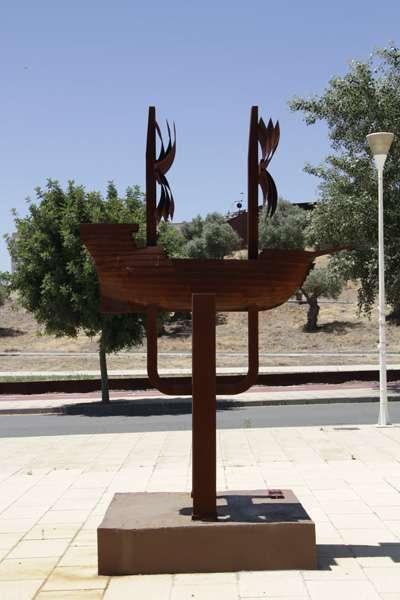Artworks
DOOR OF THE CHAPEL OF THE FORMER GRANADA CITY COUNCIL BUILDING
Description
This double door was made in the early 17th C. for the chapel of the Granada City Council premises (at the time, housed in the Madraza Palace). In the mid-20th C., it was donated to a convent, and in 2006 it was acquired by the University of Granada and returned to its original historical setting. Since 2011, it has been on display at the Madraza, following the refurbishment of the palace.
The inside of the door, which still conserves the keyhole and bolt in the form of a pomegranate, presents two oil paintings of Saint Peter and Saint Paul, by Pedro de Raxis (Alcalá la Real, Jaén, 1555–Granada, 1626). The two figures, one on each leaf, are framed in a classical architectural style, as if set on a high plinth within a round-arched niche.
Saint Peter, on the main panel of the left-hand leaf, is dressed in a dark tunic and brownish-grey cape. He is turning to his left, creating a contrapposto effect. His right hand is held up, as if testifying – an allusion to his denials during the Passion of Christ, and in his left hand he is holding the Gospels and the key to the Kingdom of Heaven.
In the right-hand leaf or ‘niche’ is Saint Paul. He is wearing a dark tunic and a red cape, and is represented as an elderly man with a long white beard, but with a strong and vigorous appearance. He, too, is in a standing position, turning to his right. In his right hand he clasps a sword that points downward, as a symbol of his martyrdom, and in his left he holds the Gospel, as author of the Epistles.
The outer side of the door was produced by Francisco Díaz del Rivero (Marcuerras, Burgos, 1592–Granada, 1670), who created the architectural format, Alonso de Mena (Granada 1587–1646), who carved the sculptures, and Pedro de Raxis, who painted the polychrome. This part of the door is reminiscent of the reredos created by these masters for the Royal Chapel.
Each leaf comprises three vertical panels. The lower panel, roughly square in shape, features a half-open pomegranate (symbol of the city of Granada) against a green lacquer background. The fruit is framed by leaves and topped with a royal crown. The large central panel houses the figure of the saint (Saint Gregory of Elvira on one leaf, and Saint Caecilius of Elvira on the other). On the uppermost panel, which is rectangular, sits a cartouche with the name of the saint in question.
Saint Gregory, who was Bishop of Granada during the second half of the 4th C., is represented in the left-hand leaf as a mature man, dressed appropriately for his position. He wears a mitre and a cape, and carries a golden crosier in his left hand, while his left hand holds a small book (a reference to his numerous writings). He is elevated on a gilded pedestal, making a slight contrapposto with his left leg.
On the right-hand leaf we find, again on a gilded pedestal, Saint Caecilius, Bishop of Granada in the 3rd C. He, too, carries the ceremonial items characteristic of his position in the Church, with a crosier in his right hand. In his left, he holds the Lead Books, in which his martyrdom is described.
Details
- Title: DOOR OF THE CHAPEL OF THE FORMER GRANADA CITY COUNCIL BUILDING
- Category: Esculturas de bulto redondo
- University: University of Granada
- Authors: Díaz del Rivero, Francisco, de Raxis, Pedro, de Mena, Alonso
- Chronology: Circa 1630
- Technique: Carved, polychrome wood
- Dimensions: 335 x 115 x 11 cm. c.u
- Stock number: 811
- Location: Palacio de la Madraza
- Ownership: University of Granada
Bibliography
Extract taken from JIMÉNEZ DÍAZ, Nieves. «Puerta de la desaparecida capilla del antiguo Ayuntamiento de Granada». Obras Maestras del Patrimonio de la Universidad de Granada. vol. II. Granada: Universidad de Granada, 2006, pp.26-28.
ECHEVARRÍA, Juan de. Noticias sagradas del glorioso patrono de Granada San Gregorio el Bético, y de su sacro templo en su fundación, progresos y presente estado. Granada: Imprenta de los Herederos de Don Bernardo Torrubia, 1773.
GÓMEZ-MORENO GONZÁLEZ, Manuel. Guía de Granada. T. I-II. Edición facsímil de 1892. Granada: Universidad-Instituto Gómez-Moreno de la Fundación Rodríguez-Acosta, 1994.
MARTÍNEZ MEDINA, Francisco Javier. San Gregorio y San Cecilio. Historia y tradiciones sobre los orígenes del cristianismo en Granada. Granada: Facultad de Teología, 1997.
AA.VV. San Gregorio y San Cecilio. Patronos de Granada. Granada: Facultad de Teología, 2001.
MOYA MORALES, Javier. Obra dispersa e inédita. Granada: Instituto Gómez-Moreno de la Fundación Rodríguez-Acosta, 2004.


 EN
EN  ES
ES 




